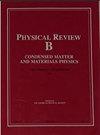Transient superconductivity without superconductivity
IF 3.7
2区 物理与天体物理
Q2 MATERIALS SCIENCE, MULTIDISCIPLINARY
引用次数: 22
Abstract
Recent experiments on ${\mathrm{K}}_{3}{\mathrm{C}}_{60}$ and layered copper-oxide materials have reported substantial changes in the optical response following application of an intense THz pulse. These data have been interpreted as the stimulation of a transient superconducting state even at temperatures well above the equilibrium transition temperature. We propose an alternative phenomenology based on the assumption that the pulse creates a nonsuperconducting, though nonequilibrium, situation in which the linear response conductivity is negative. The negative conductivity implies that the spatially uniform prepulse state is unstable and evolves to a new state with a spontaneous electric polarization. This state exhibits coupled oscillations of entropy and electric charge whose coupling to incident probe radiation modifies the reflectivity, leading to an apparently superconductinglike response that resembles the data. Dependencies of the reflectivity on polarization and angle of incidence of the probe are predicted and other experimental consequences are discussed.无超导的瞬态超导
最近在${\mathrm{K}}_{3}{\mathrm{C}}_{60}$和层状氧化铜材料上的实验报道了在应用强太赫兹脉冲后光学响应的实质性变化。这些数据被解释为瞬态超导状态的刺激,即使在远高于平衡转变温度的温度下。我们提出了另一种现象学,基于假设脉冲产生非超导,尽管非平衡,在线性响应电导率为负的情况下。负电导率意味着空间均匀的预脉冲状态是不稳定的,并演变成一个具有自发电极化的新状态。这种状态表现出熵和电荷的耦合振荡,它们与入射探针辐射的耦合改变了反射率,导致类似于数据的明显的超导响应。预测了反射率与探针的偏振和入射角的关系,并讨论了其他实验结果。
本文章由计算机程序翻译,如有差异,请以英文原文为准。
求助全文
约1分钟内获得全文
求助全文
来源期刊

Physical Review B
PHYSICS, CONDENSED MATTER-
CiteScore
6.30
自引率
32.40%
发文量
4177
期刊介绍:
Physical Review B (PRB) is the world’s largest dedicated physics journal, publishing approximately 100 new, high-quality papers each week. The most highly cited journal in condensed matter physics, PRB provides outstanding depth and breadth of coverage, combined with unrivaled context and background for ongoing research by scientists worldwide.
PRB covers the full range of condensed matter, materials physics, and related subfields, including:
-Structure and phase transitions
-Ferroelectrics and multiferroics
-Disordered systems and alloys
-Magnetism
-Superconductivity
-Electronic structure, photonics, and metamaterials
-Semiconductors and mesoscopic systems
-Surfaces, nanoscience, and two-dimensional materials
-Topological states of matter
 求助内容:
求助内容: 应助结果提醒方式:
应助结果提醒方式:


